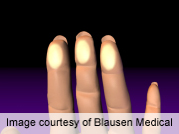Cold-induced decrease in skin temperature inversely linked to age, BMI in patients not controls
FRIDAY, Jan. 16, 2015 (HealthDay News) — For patients with Raynaud’s phenomenon (RP), cold-induced decrease in skin temperature is related to age and body mass index (BMI), according to a study published in the January issue of Arthritis & Rheumatology.
Georgiana-Aura Giurgea, M.D., from the Medical University of Vienna, and colleagues examined the correlation of age and BMI to skin temperature and perfusion in patients with primary RP. Twenty-six patients and 22 age- and sex-matched controls underwent external cold provocation by exposure to 20 degrees Celsius water for one minute.
The researchers found that cold exposure led to a median change in skin temperature of −7 percent and a median change in skin perfusion of −26.4 percent in RP patients. Upon cold exposure, skin temperature and skin perfusion changed by −15.7 and −33 percent, respectively, in controls. Age and BMI correlated with skin temperature and skin perfusion in patients with RP, but not in controls. In patients with RP, but not controls, there was an inverse relationship between the cold-induced decrease in skin temperature with age and BMI. There was no association between cold-induced change in skin perfusion with age or BMI in either group.
“Further studies are needed to clarify the pathophysiology of digital ischemia in primary RP,” the authors write.
Copyright © 2015 HealthDay. All rights reserved.





